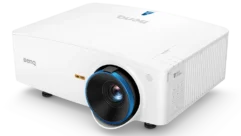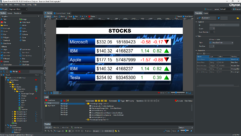
Technology Showcase: Interactive Presentations
Sep 1, 2007 12:00 PM,
By Jay Ankeney
Interactive whiteboards provide a new level of communication.

NEC ImagineX IW77
Even under the onrush of digital communication, for many personal presentation purposes, the most effective communications tool is the ultimate in analog — the human hand. If you need to stand in front of a conference-room meeting — or for that matter before a classroom of students — there is nothing like being able to write grandly handwritten letters on a presentation surface, add dramatic swoops for emphasis, or lasso an emphatic circle around key words. Just as Picasso was said to be incapable of drawing an inartistic line, meeting-room presenters know that an element of personal expression is inherently added with the human touch.
But gone are the days of blackboards and chalk. Today’s presentation technologies let us combine digital data with our own manual scribblings — and even get electronic feedback from the audience, making the conversation truly interactive.

Hitachi StarBoard FX Series
One of the fastest-growing technologies enabling this is the interactive whiteboard (IWB). During the 1990s, using inert whiteboards — often with special dry-erase pens — started replacing the green or black clay surfaces of yesteryear. This had the ancillary benefit of eliminating the dust to which some presenters were allergic and protecting the audience from those spine-twisting chalk squeaks that could awaken even the drowsiest 10 o’clock scholar.
As digital technology became available, images on these whiteboards could either be printed to paper or scanned into JPEG files for retrieval later, turning the writing surfaces into electronic copyboards. An electronic copyboard put the information from the board into storage, but it provided little interactivity with the data’s creation.

Interwrite Learning Interwrite Board
Over the last decade, however, as PCs became ubiquitous and laptops replaced briefcases, truly interactive systems were developed that allowed you to put information from your computer’s desktop onto the screen and then save any manipulations of that data made on the screen’s surface to the computer. This has lead to the development of the interactive whiteboard, which now comes in a broad spectrum of configurations.
Manual input onto those IWB surfaces can involve electromagnetic pens, touch-sensitive surfaces, infrared grids that can detect multicolored pens, ultrasound sensing, or creative combinations of the above. A recent popular innovation is a short-throw projector that sits directly above the whiteboard, eliminating any shadows that a rear-wall projector would create.
If the manual flexibility of drawing on the board is beyond your graphic skills, you could always use a laptop’s keypad or a Wacom-style drawing tablet. With wireless laptops becoming widespread, any of the conference-room participants can add to the information flow, creating a truly interactive experience.
One of the most recent additions to interactive presentation communication is audience response technology, which puts a keypad in the hand of everyone watching the presentation. These polling keypads, which look similar to a conventional remote control, invite people to respond to questions anonymously or add their own input from their seats just by keying their opinions into small, handheld devices.

Numonics Intelliboard
If interactive whiteboards empower sessions directed by the session’s conductor, listener-polling feedback technology can make the experience audience-driven. Long used by media focus groups, these audience-polling systems were originally equipped with long, tethered wires. Now, they are mostly wireless for convenient use — even in the largest venue.
Interactive whiteboards have experienced a rapid growth spurt as governments are starting to appreciate their assets provided to the classroom experience, and corporate installations are riding the same wave. Decision Tree Consulting (DTC) has been tracking the interactive whiteboard market worldwide since 2001. The company’s senior consultant, Colin Messenger, predicts interactive whiteboards will be a $1 billion market by 2008. According to DTC, there are now 1.2 million boards installed, and that number is expected to grow to 5.3 million by 2011.
We are going to look at several variations of interactive presentation technologies and explore the diverse options available to today’s corporate conference rooms, training centers, and academic classrooms. Here are some of the more interesting interactive whiteboard options and audience-response polling systems on the market today.
The 3M Digital Media System 800 series is a short-throw projector line from the company that invented the Vikuiti super-close projection digital wall display in 2001. The Digital Media System 800 is a Vikuiti HQV (Hollywood Quality Video) Super Close projector and 40W stereo surround-sound TruSurround XT sound system designed to work with any interactive whiteboard by throwing 50in. to 85in. super-close projection images onto it. Because the projector is mounted on a telescoping arm directly over the whiteboard, there are no shadows created by the presenter to distract from the projected images. The company’s latest offering, the 3M Digital Media System 815, adds a receptor pod that uses infrared and ultrasound technology and can be mounted over any whiteboard or writing surface. This approach completely replaces digital projectors, audio loudspeakers, audiovisual carts, and the expense of installing all of this equipment, yet it gives you mobile interactivity that can be transported from room to room.
The Classroom Performance System (CPS), from eInstruction is a hardware/software system that links every participant to everyone in a classroom or conference-room setting by wirelessly connecting each person through a personal response pad. The results are displayed instantly on the presenter’s receiver in a PowerPoint graph, allowing for on-the-fly customization of instructional sessions. With its new data-slicing feature, a presenter using the CPS system is able to view response data based on any category created, and the results can be displayed on a whiteboard, flatpanel TV, or projector. Currently, there are approximately 7,000 CPS-empowered classrooms in the United States and other western countries.

PolyVision Walk-and-Talk Lightning
The StarBoard FX series of interactive whiteboards from the Hitachi Software Engineering America‘s Interactive Media Solutions Group use a combination of infrared and ultrasound sensors. The series features large-format image areas (63in., 77in., and 82in. diagonal), with durable, anti-glare, steel-backed projection surfaces for both electronic sensing-based and dry-erase writing. Instead of having a monitor on the podium, the presenter can write on the Hitachi Software T-17SXLG pen display, a 17in. LCD that comes with a built-in projector pass-through to deliver an interactive lesson that originated from a laptop. Driven by the same powerful software as the StarBoard interactive whiteboards, the T-17SXLG also includes an easily adjustable angle stand, VESA mount adapters, and a wireless stylus. All electronics are placed in a field-replaceable sensor, leaving no wires, membranes, or circuits on the surface.
The Interwrite Learning Interwrite Board has a durable surface and a Bluetooth wireless option, along with an optional wall-mounted 3M projector. It features patented electromagnetic digitizing technology, which delivers up to 4,096 lines per inch, high-resolution clarity. Using pens with electromagnetic technology, its Interwrite Workspace software includes thousands of images and resources. The company also invented the Interwrite Pad, a portable Bluetooth device that can be passed around a presentation room so participants can write on it. Or, if the presenter wants to stand at a podium, the Interwrite Panel combines a USB-connected monitor screen with a electromagnetic surface that allows you to see what you are putting on the screen without turning your back on the audience. In addition, the Interwrite Cricket audience-response system lets the participants provide feedback that can be tallied by the computer’s software.
Having become a division of Sanford Brands last October, Mimio now offers Mimio Interactive, a portable, low-cost infrared and ultrasound tracking device that attaches to any whiteboard up to 4’x8′. The Mimio Interactive sensor connects to a presenter’s PC, and when used with a projector, it allows presenters to control their desktop applications and documents directly from the surface of any board you can write on. When used with a multimedia projector, presenters can take Mimio Interactive from room to room and use the ergonomic Mimio Mouse stylus like a cordless mouse to control (click, right-click, and drag and drop) computer applications and documents directly from any board’s surface. If used with a whiteboard, once Expo dry-erase markers are inserted into the Mimio stylus pens, everything that the presenter writes or draws on the whiteboard is digitally recorded in color and realtime in a highly portable digital data format.
The new ImagineX IW77 interactive whiteboard from NEC can be used seamlessly with all NEC projectors for an integrated teaching/learning solution. For flexible presentation capabilities, the ImagineX IW77 comes with three different interactive tools: Scrapbook, Desktop Palette, and PowerPoint Palette. NEC’s Scrapbook application turns the image on the whiteboard into a digital workspace where you can record notes and import screenshots and other files as background images. The NEC Desktop Palette provides quick selection of major functions, including annotation and a pop-up keyboard. The NEC PowerPoint Palette allows annotation of, and navigation from, slide presentations. The ImagineX IW77’s mouse functionality makes it easy for users to control the desktop directly from the board with just a stylus, while the integrated PowerPoint presentation control allows almost instantaneous use of PowerPoint files in slideshow mode.

Smart Technologies Smart Board 600i
Numonics offers its Intelliboard(I-Board) as its flagship interactive whiteboard. Compatible with either Mac or Windows operating systems, the I-Board features 17 user-definable softkeys on both sides of the board, which can be defined to launch websites, applications, files, and keyboard commands, along with any of the 14 different presentation tools. The company’s Interactive Presentation Manager (IPM) is an advanced interactive whiteboard that also has 17 user-definable softkeys located on both sides of the board. Numonics also has an entry-level whiteboard, the Digital Presentation Appliance (DPA). If the presenter needs a mobile presentation unit, the Mobilepresenter BT II offers many of the same features as a whiteboard, but it is controlled through a two-button pen on a handheld pad, allowing the teacher or presenter freedom of mobility by communicating with a computer through a wireless Bluetooth interface that plugs into a USB port on the computer.
The PolyVision Walk-and-Talk Lightning is the world’s first calibration-free interactive whiteboard. With other projector-based interactive whiteboards, if the touch-sensitive board or the rear-wall-mounted projector is bumped, proper registration between source and screen has to be manually reset. When you press a button on the Walk-and-Talk remote control, it calibrates the screen instantly using Photonic Array technology. The system automatically detects the light from the projector with photo sensors and associates that information with specific pixels on the computer display. Under PolyVision’s FUMIFU (First Use Must Inspire Future Use) philosophy, presenters can instantly load the PolyVision PolyKey driver for walk-up-and-use operation or choose its more sophisticated Webster software for advanced users. The Walk-and-Talk Lightning interactive whiteboard is compatible with any presentation software.

Turning Technologies ResponseCard XR keypads
Promethean designed its Activboard with a durable hard surface to survive the most challenging environments for an interactive whiteboard. All connectivity options, including USB, serial port, and Bluetooth, are integrated and available right out of the box. The Activboard also has built-in RF connectivity to other Promethean peripherals, including the company’s wireless Activslate pass-around mini-board. Its Activote feedback modules ensure audience engagement through their ongoing participation. Promethean Activstudio software helps presenters bring subjects across a whole range of topics to life by providing more than 15,000 readily accessible lessons, images, backgrounds, shapes, annotations, and activities.
Reply Systems, a division of Fleetwood Group, uses RF technology for realtime data collection from even large audiences watching an interactive presentation. Fleetwood invented two-way wireless audience-response technology in 1989, and it has been granted eight U.S. and European patents. Reply Systems’ RF keypads use eligible license-free/license-exempt frequencies to communicate key presses to the base station and receive control information and acknowledgements of successful keypad entries. The company’s top-end model, Reply IQ, allows multiple numeral entry responses and user IDs (up to 16 characters). Its large graphic LCD displays detailed questions and response options involving up to eight lines of text. The company’s lower-cost Reply (Worldwide) is a small, frequency-hopping spread-spectrum system. Because it operates in the unlicensed 2.4GHz band, Reply (Worldwide) is available for sale to the United States (FCC certified), Canada (IC certified), and Europe (CE certified), as well as many other international regions. This summer, the company combined the features of Reply IQ and Reply (Worldwide) into a midrange-version keypad, the WRS7200, that can also handle multiple-digit entry when it is used with the Reply Solo (WRS960X) base station.
Having pioneered this presentation technology, Smart Technologies claims, “Anything you can do with a mouse on a computer, you can do with your finger on the Smart Board interactive whiteboard.” With the Smart Board 600i interactive whiteboard system, a push of a button puts the presenter in control of a powerful multimedia environment because it is an all-in-one design that brings an interactive whiteboard, projector, and audio system together. The Unifi 35 projector’s high-offset, short-throw design reduces shadows on the interactive whiteboard and keeps light from shining in the presenter’s eyes. The company’s AirLiner wireless slate lets the presenter interact with the Smart Board from anywhere in the class because anything written on the slate appears immediately on the board. Smart Board’s Senteo interactive response system provides a direct wireless connection between presenters and their listeners to determine if what was said is actually what was heard.
TurningPoint 2008 software is the latest version of Turning Technologies‘ audience-response system, which can be used on a presenter’s PC or laptop. TurningPoint 2008 turns any live audience event into an educational interactive experience by adding a toolbar to the presenter’s PowerPoint display that automatically graphs the respondents’ input. Ask your question, and the audience can use their ResponseCard XR keypads to provide new reporting options, including scoring distribution, statistical, percentile, team scoring, answer choice, and updates to participant reports. Because it is 100 percent native to Microsoft’s PowerPoint application, TurningPoint 2008 works within PowerPoint by taking professionally designed templates and editing them using the TurningPoint toolbar to suit the presenter’s needs.
For More Information
eInstruction
www.einstruction.com
Hitachi Software
www.hitachi-soft.com
Interwrite Learning
www.interwritelearning.com
Mimio
www.mimio.com
Numonics
www.numonics.com
PolyVision
www.polyvision.com
Promethean
www.prometheanworld.com/us
Reply Systems
www.replysystems.com
Smart Technologies
www.smarttech.com
Turning Technologies
www.turningtechnologies.com










